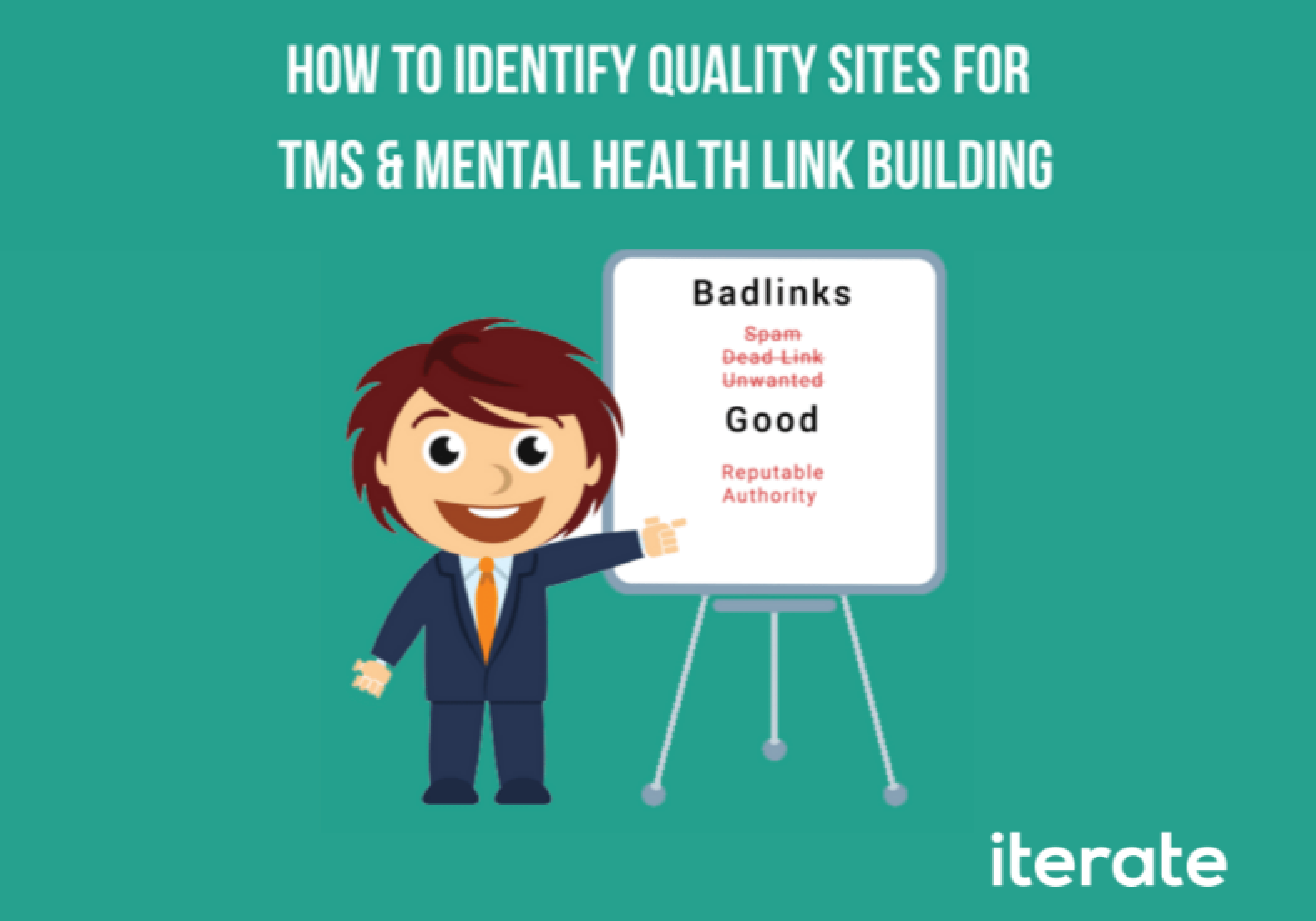Note: This article is repurposed from our new book, “The Content Marketer’s Guide to Ideation.” This massive 187-page guide is available free as a PDF (get it here), and is also available in Kindle and paperback.
You can’t produce great content marketing if you don’t have great topics. Topics are the seeds of content ideas. If you’re running low on great ideas, you may simply need to find more topics to write about. We’ve compiled together nine of our favorite exercises for generating new topics based off of the ones you’re already covering in your content marketing.
These exercises give you the opportunity to “atomize” your core topics in your own way, and not the way that others have structured their own topics, or the way that keyword tools spit topics back at you. The value is in how you restructure and reorganize. Think of these exercises as a more hands-on, playful form of research. The key word here is playful—a word we rarely use in the business world, and one you’ll have to get comfortable with.
Here are the nine exercises we’ll cover:
- Top Down Tree
- Bottom Up Tree
- Mind Mapping
- The 4 C’s
- SCAMPER
- Fishbone Diagram
- SQUID
- Synesthesia
- Heart, Hand, Mind
What is “Chunking”?
Before we launch into exercises, it’s important to understand that topics are simply “chunks” of information. To make sense of the natural world, our minds automatically chunk items to interpret them. Chunks are bits of information you assign some meaning to. Most of topic expansion comes down to fleshing out chunks and repurposing them in different ways.
Developing chunks comes about by Chunking Up and Chunking Down. Chunking Up allows you to see the bigger picture. Chunking Down allows you to see small details. Both can be helpful for content ideation. Chunking will help you zoom in and out, but it will also push you towards lateral topics, too.
Many of the exercises in this chapter focus on developing chunks. The most basic exercises to help you Chunk Up or Chunk Down are known as the Top Down Tree and Bottom Up Tree.

What Are Chunks?
Chunks should be small enough to be helpful and large enough to hold meaning and to be written about. Chunks should be no more than one or two words. They should be unambiguous.
Examples of Chunks:
- Pines
- Pine Tree
- Fores
- United States
- North America
- Western Hemisphere
- Earth
- Milky Way
One of the big values of chunking as an exercise is that it trains the mind to look both ways when considering ideas. When thinking about problems, some people’s minds immediately jump to details, while others look at problems from a big-picture perspective. Neither is universally preferable, both mindsets should be used to generate the best possible content ideas.
This article is repurposed from our new book, “The Content Marketer’s Guide to Ideation.” This massive 187-page guide is available free as a PDF (get it here), and is also available in Kindle and paperback.
#1: Top Down Tree
The Top Down Tree is used to chunk down and look more closely at the details behind the topic or problem. You’re not looking for relationships; you’re simply looking to follow your logical mind to arrive at details. The Top Down Tree can also be very useful for diagnosing the source(s) of a problem.
Any time the layperson doesn’t understand what your business does or what your core topics really mean, your content should attempt to resolve that lack of understanding. Unfortunately, most marketers don’t spend the time to analyze their topics layer by layer to inform their customer base. The Top Down Tree can help you do just that.
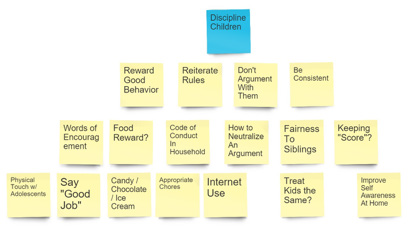
A productive Top Down Tree in progress
From: Rapid Problem Solving with Post-It Notes by David Straker
The Top Down Tree can be displayed either vertically down a whiteboard or sheet of paper, or it can be done left to right.
The Exercise:
- Start with a core topic.
- Choose a starting point (top or far left of work area).
- Write “children” of the topic—either on the spot or with pre-written chunks that you’ve shuffled in advance.
- Reposition children if necessary as you build.
- Add lines to show relationships.
From: Rapid Problem Solving with Post-It Notes by David Straker
#2: Bottom Up Tree
Sometimes you have a lot of different data points and you’re too zoomed in on the topic or problem to be able to generate anything new. You know you can create something new and unique, but you’re not sure if it even relates back to the core problem.
The Bottom Up Tree is a useful exercise for getting to the root of an issue and for zooming out to larger, more interesting and shareable topics. When you sit in a conference room arguing with your colleagues about what the real problem is, a quick Bottom Up Tree can help resolve a dispute.
The Exercise: Follow the same five instructions you followed for the Top Down Tree.

Example: Let’s say you manufacture access doors, a small piece of building construction equipment.
By Chunking Up, you can find a larger topic relevant to your audience, and with much broader appeal. If your goals are traffic generation or brand awareness, the Bottom Up Tree may become one of your go-to exercises.
A Note on Tree Size
Bottom Up Trees are usually much more shallow than Top Down Trees. They can be only two or three levels deep. A tree with 20 or more chunks is usually the most helpful. If you find your tree is too shallow, try to Chunk Down further before Chunking Up.
#3: Mind Mapping
Maps can help you understand the relationship between concepts and Ideas. You can use them to unpack complex topics, but also to better understand the connections between seemingly disparate topics.
Mind mapping is a visual tool for thinking. Other mapping techniques are used to organize ideas and build relationships, but Mind Mapping provides an early-stage, free-form tool for discovery.
The Exercise:
- Write a topic in the center of the page.
- Write words that flow from that topic. These are your first branches. Don’t fret over rationale or try to be too precise or logical. If your first branches are too specific, your map won’t be helpful.
- Add sub-branches off your main branches.
- Connect your words. As you connect, your mind will draw relationships between concepts and allow you to better express entangled topics and Artifacts.
Feel free to draw pictures instead of using words. Use color or stylized writing to better explain relationships or key in on important concepts. Mind mapping is about being creative and empowered, not logical and precise.
Study the map for a few minutes. Whether great ideas bubble up or not, put the map away for a couple days and come back to it. You’ll likely find something completely new and interesting when you come back.
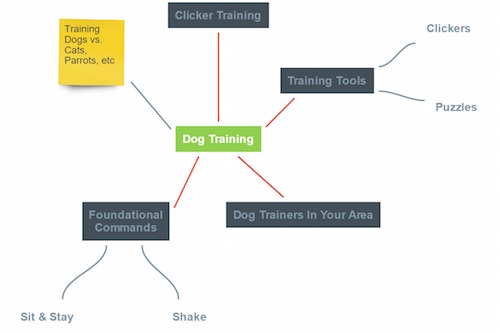
There are several great tools on the web for generating mind maps. Sometimes, getting out pen and paper or a whiteboard and pens can seem like a lot of work to quickly map out your thoughts, and these solutions may be easier. Many have the added benefit of letting you share your ideas with colleagues via the cloud. Try these:
www.mindjet.com
www.xmind.com
www.bubble.us
www.mindmapper.com
www.stormboard.com
This article is repurposed from our new book, “The Content Marketer’s Guide to Ideation.” This massive 187-page guide is available free as a PDF (get it here), and is also available in Kindle and paperback.
#4: The 4 C’s
The 4 C’s is a method of deconstructing topics or problems into their component parts. This is a group exercise that can handle a large numbers of attendees, and will benefit greatly from four participants.
The Exercise:
Draw a 2×2 box on a piece of paper or whiteboard. In the cells, write “Components, Characteristics, Challenges, and Characters.” The definitions:
- Components: What are the pieces that constitute the product/service/idea?
- Characteristics: What is the product/service/idea like? List out features and physical characteristics.
- Challenges: What are the market challenges facing your core topic?
- Characters: Who are all the players involved?
Example: “basketball shoes”
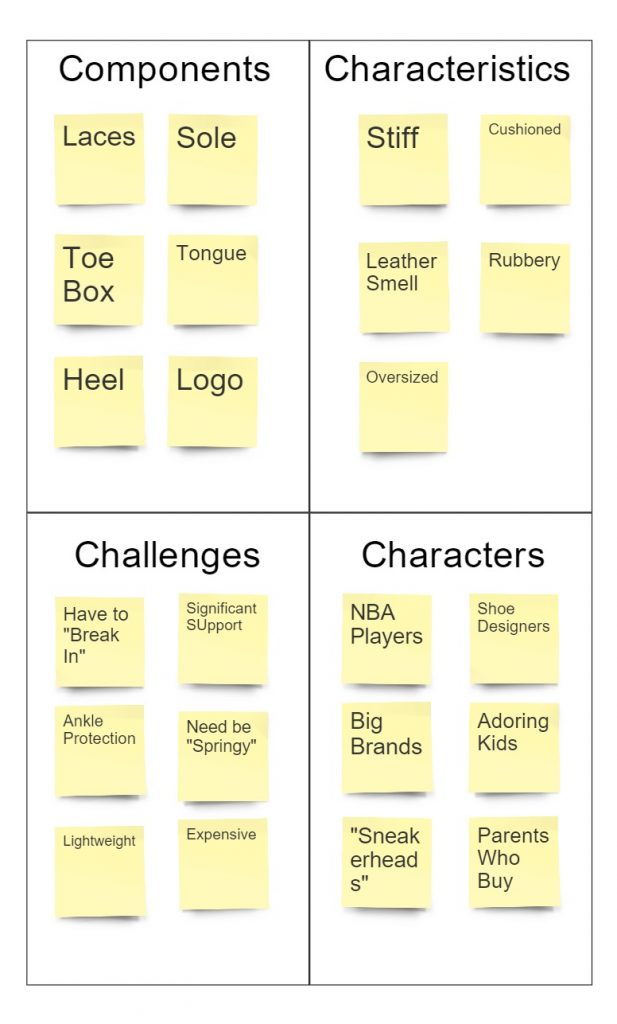
Complete one category at a time, placing sticky notes into each category, or writing in pen in each square of your page. This is a quick way of getting a lot of chunks out on paper, in a formalized process.
Group Exercise. Follow this process with a group of 8 or more:
- Challenge your team members to use everything they know about your topic to generate maximum output in each category.
- Give each team member a pad of sticky notes and a marker. Assign multiple team members to each of the four categories.
- Explain the 4 C’s, and invite team members to discuss their specific category for five minutes among themselves.
- Have each team write out their chunks on sticky notes for no more than five minutes.
- Ask a volunteer from each team to present their team’s findings.
- As each volunteer presents, ask the other participants to spot any missing Artifacts, topics, or Ideas.
This game tends to be very effective in large groups with a very limited amount of time. Some of the major benefits are exposing all team members to diversity of opinion and building consensus about some of the core features of a topic.
From: Matthew Richter, March 2004 publication of the Thiagi GameLetter
#5: SCAMPER
The SCAMPER method is a well-known thinking tool to help explore a topic and its uses. Sometimes it leads to interesting new data-points or topics, and often it will lead straight to new content Ideas.
The seven letters of SCAMPER stand for:
- Substitute. What can you replace it with?
- Combine. What can you combine it with?
- Adapt. How could you rework it as a solution?
- Modify. Can you change it in any way?
- Put to other uses. How else can you use it?
- Eliminate. Can you remove something core to it? Something unnecessary?
- Rearrange. Can you rearrange its components to create something new?
Use each of the prompts to produce as many ideas as you can. The temptation is to pick and choose only letters you think are relevant to the chosen topic.
Another way to leverage the SCAMPER method is to use it in a group session to combine the ideas of all of your team members.
The game was developed by Robert F. Eberle and covered at length in his book Scamper: Creative Games and Activities for Imagination Development.
#6: Fishbone Diagram
The Fishbone Diagram forces you to deconstruct a process to pull out topics. The diagram puts the topic in the center of the page and forces you to generate causes around it. Those causes can become new ideas to explore.
One of the great benefits of the Fishbone is that it needs to be completed. You can’t ditch it halfway through because you came up with a good enough topic. The exercise should take anywhere from 30 minutes to an hour to complete
The Exercise:
- Draw a horizontal line across the center of a whiteboard or sheet of paper.
- Draw several spurs coming off of the line at 45-degree angles. You can always add more if more comes to light.
- Begin filling in spurs—major causes.
- As sub-spurs come to mind, begin building outward off of your spurs.
- After completion, circle any major areas that stand out to you as areas for further exploration.
- If necessary (for presentation purposes) re-draw the diagram after the exercise is finished to make it more clear.
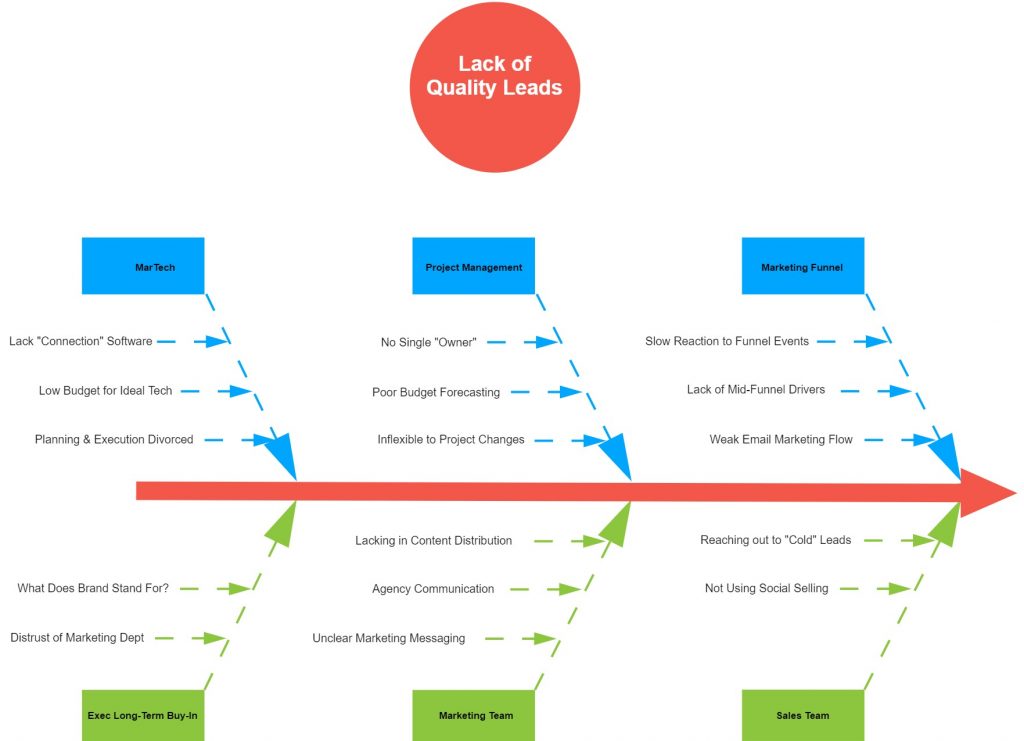
The exercise was developed by Professor Kaoru Ishikawa and is also known as an Ishikawa Diagram.
This article is repurposed from our new book, “The Content Marketer’s Guide to Ideation.” This massive 187-page guide is available free as a PDF (get it here), and is also available in Kindle and paperback.
#7: SQUID
SQUID is a structured, sequential-thinking exercise for working through the questions and answers related to a topic. It’s great for logic-driven, analytical thinkers, as it gives them plenty of structure—the complete opposite of a traditional brainstorm session.
It’s especially useful when you’re struggling to find new Evergreen Ideas in your niche and you feel tapped out. Often, in a group setting, you’ll generate new customer questions to be answered. SQUID can be done individually, but I recommend doing it in a 30-minute group session.
The Exercise:
- Write a core topic on the far left-center of a whiteboard.
- Hand out two different colored sticky notes to your participants.
- Ask a participant to write a question about the topic.
- Ask the other participants to write an idea for an answer on a single sticky note.
- Repeat #3 and #4 until you’ve filled the board with questions and answers and you’re satisfied with your haul.
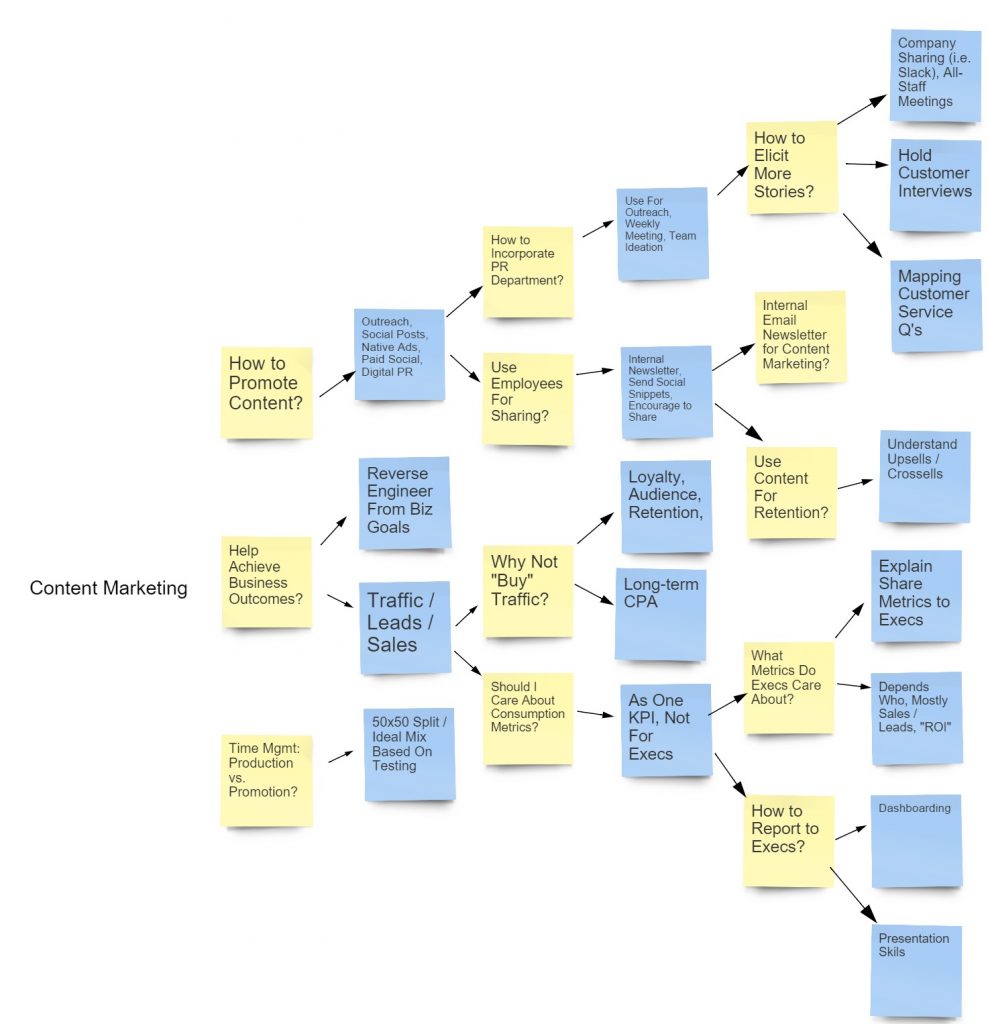
From Gamestorming by James Macanufo and Sunni Brown
#8: Synesthesia
Synesthesia is an ideation method best used to create topics and ideas that are rich in imagery and feeling. It can help develop some of your most powerful, shareable content. Since Synesthesia works best with topics that evoke imagery, a very complex product that lacks a lot of associations may not be a good fit.
This exercise is unlike many others because it relies on your senses rather than your brain. It’s a great break from brainy day-to-day ideation. It can be done solo, but it’s best done in groups. The best group consists of five imaginative participants, one assigned to each sense perception. Limit the number of participants if you can’t find people who are open-minded and imaginative.

The Exercise:
- Choose a core business topic to explore.
- Assign each participant with one sense: See, Hear, Taste, Smell, Touch.
- Give the participants five minutes to write about how the topic relates to their assigned sense.
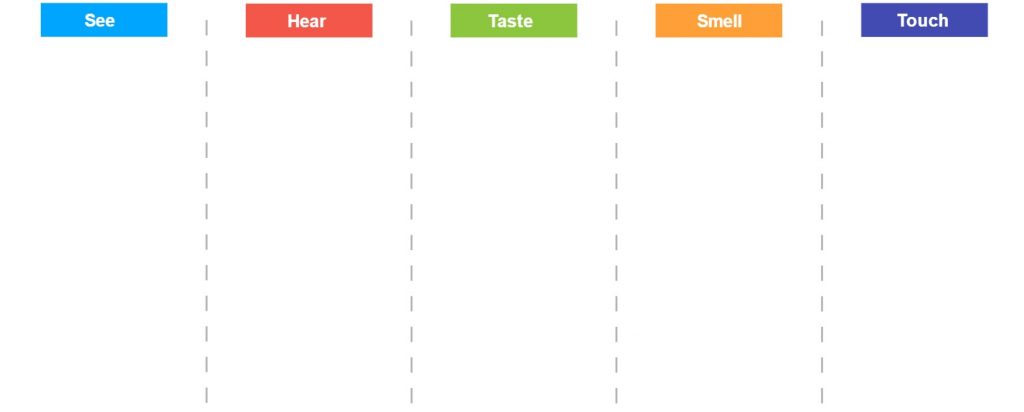
Discovering how participants relate to the topic and what they feel when they think of the product, service, or topic can be a huge eye opener for ideators. At the least, you should walk away with some tremendous emotional language and imagery to include in future content.
From Gamestorming by James Macanufo and Sunni Brown
#9: Heart, Hand, Mind
Finding all of the reasons why your topic or product/service solution is the right one can prime the mind to find new arguments that can be used in bottom-of-funnel, conversion-focused content. We often go down the same paths looking for fresh angles. Every content strategy and ideation team needs a mix of Heart, Hand, and Mind.
Heart, Hand, Mind is a game developed in the book Gamestorming, adapted from the work of Heinrich Pestalozzi. The exercise can be run solo or in groups and should take no longer than 20 minutes if run solo. The definitions:
Heart: What makes it emotional?
Hand: What makes it tangible and practical?
Mind: What makes it logical and sensible?
The Exercise: List characteristics for each of the three categories, filling a whiteboard or stopping after 20 minutes.
Many content marketers may take a topic and write consistently about one category or another, usually Hand or Mind when writing content for potential customers. The more we can integrate all three categories into our content pieces, the better our chances for success.
Example: Subject is “weight-loss surgery”
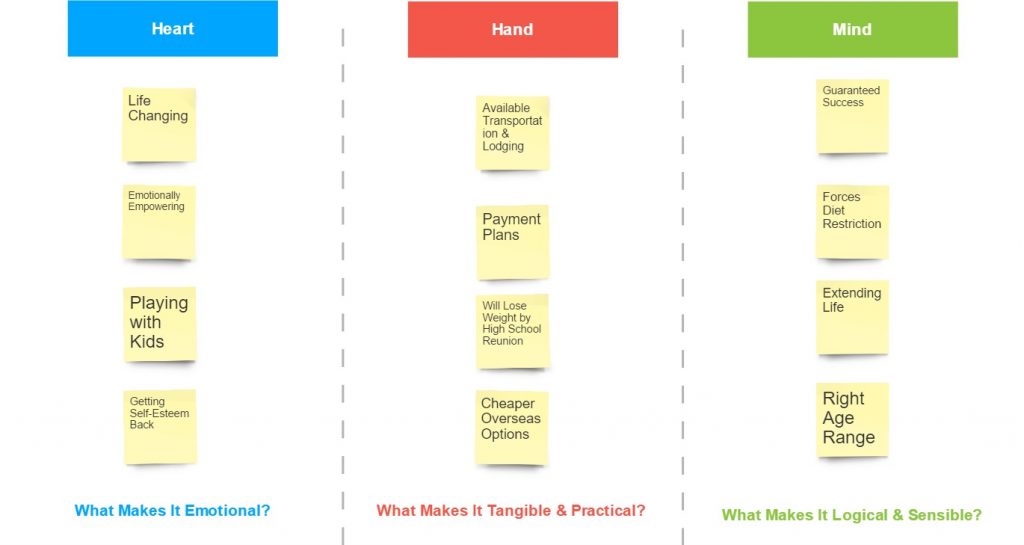
From Gamestorming by James Macanufo and Sunni Brown
Record Everything!
Take detailed notes and save them digitally. These exercises will produce a ton of seemingly “useless” data-points amongst some great new content topics. It may take further research, or simply just the passing of time before new topics reveal themselves out of your mess of notes. Just don’t let all those great “nuggets” go to waste.
It’s important to remember that no single exercise is the best and that some can be used more frequently than others. Choosing exercises, on some level, is about assessing your current topics and matching the exercise’s potential for producing results from those topics. That environment will change project by project. Best of luck in expanding your content topics!
This article is repurposed from our new book, “The Content Marketer’s Guide to Ideation.” This massive 187-page guide is available free as a PDF (get it here), and is also available in Kindle and paperback.



